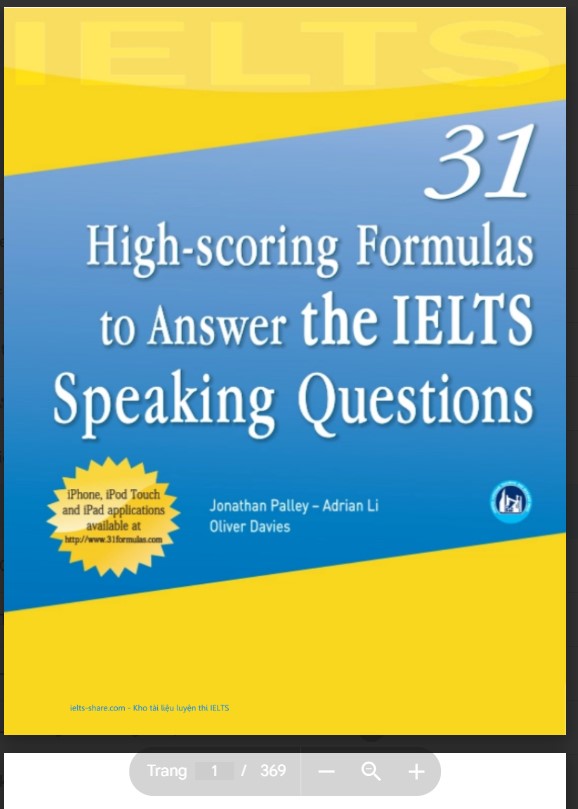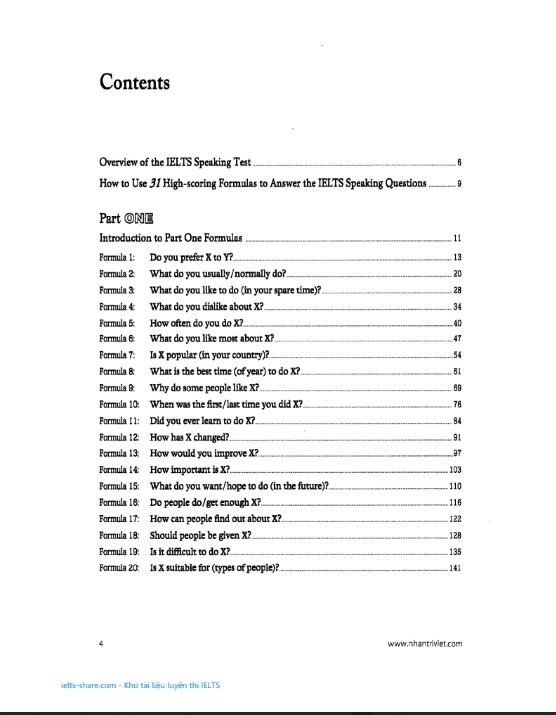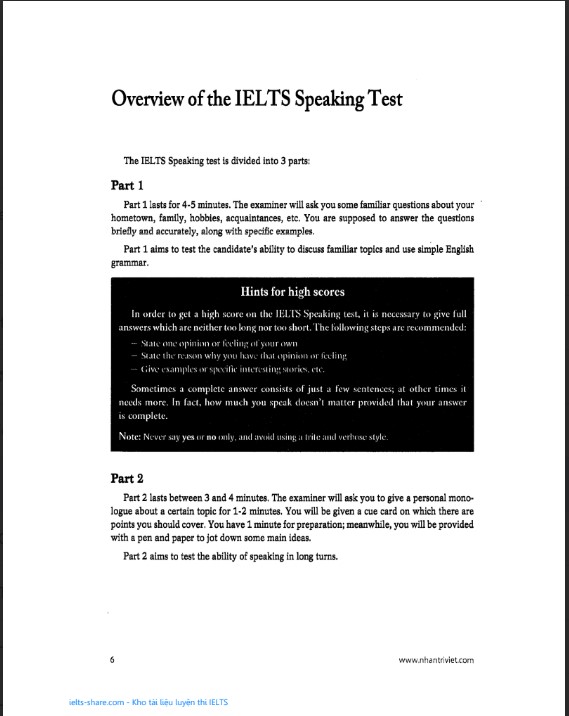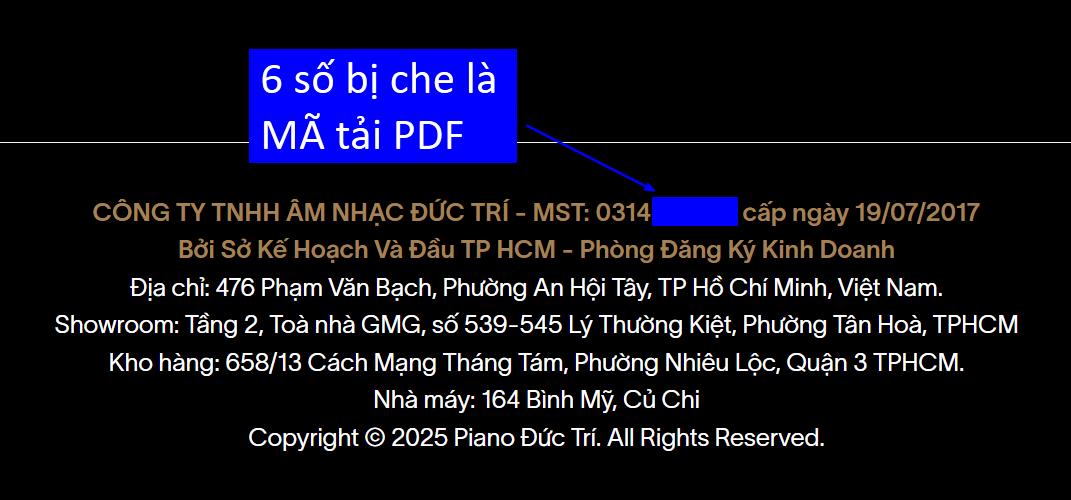


Contents
Overview of the IELTS Speaking Test …………………………………………………… 6
How to Use 31 High-scoring Formulas to Answer the IELTS Speaking Questions ……………… 9
Part ONE
Introduction to Part One Formulas …………………………………………………… 11
Formula 1: Do you prefer X to Y? ………………………………………………………… 13
Formula 2: What do you usually/normally do? ……………………………………….. 20
Formula 3: What do you like to do (In your spare time)? …………………………… 28
Formula 4: What do you dislike about X? ……………………………………………….. 34
Formula 5: How often do you do X? …………………………………………………….. 40
Formula 6: What do you like most about X? ………………………………………….. 47
Formula 7: Is X popular (in your country)? ……………………………………………… 54
Formula 8: What is the best time (of year) to do X? …………………………………. 61
Formula 9: Why do some people like X? ………………………………………………… 69
Formula 10: When was the first/last time you did X? ………………………………. 76
Formula 11: Did you ever learn to do X? ……………………………………………….. 84
Formula 12: How has X changed? …………………………………………………………. 91
Formula 13: How would you improve X? ………………………………………………. 97
Formula 14: How important is X? ……………………………………………………….. 103
Formula 15: What do you want/hope to do (in the future)? ……………………… 110
Formula 16: Do people do/get enough X? …………………………………………… 116
Formula 17: How can people find out about X? …………………………………….. 122
Formula 18: Should people be given X? ………………………………………………. 128
Formula 19: Is it difficult to do X? …………………………………………………….. 135
Formula 20: Is X suitable for (types of people)? …………………………………… 141
Part TWO
Introduction to Part Two Formulas …………………………………………………… 147
Formula 21: Person Monologue…………………………………………………………. 149
Formula 22: Place Monologue……………………………………………………………. 177
Formula 23: Object Monologue………………………………………………………….. 204
Formula 24: Past Event Monologue…………………………………………………….. 234
Part THREE
Introduction to Part Three Formulas ………………………………………………… 267
Formula 25: Giving and Supporting Opinions……………………………………….. 269
Formula 26: Evaluating Two Different Opinions……………………………………. 279
Formula 27: Agreeing and Disagreeing……………………………………………….. 286
Formula 28: Talking about Advantages and Disadvantages………………………. 300
Formula 29: Expressing Importance and Priority…………………………………… 310
Formula 30: Proposing Solutions to Problems………………………………………. 321
Formula 31: Speculating about Future Events and Outcomes…………………… 329
Appendices
Top 10 Do’s and Don’ts for the IELTS Speaking Test………………………………….. 339
Verbs Most Commonly Misused by IELTS Candidates……………………………….. 340
Answer Key………………………………………………………………………………………. 343
Overview of the IELTS Speaking Test
The IELTS Speaking test is divided into 3 parts:
Part 1
Part 1 lasts for 4-5 minutes. The examiner will ask you some familiar questions about your hometown, family, hobbies, acquaintances, etc. You are supposed to answer the questions briefly and accurately, along with specific examples.
Part 1 aims to test the candidate’s ability to discuss familiar topics and use simple English grammar.
Hints for high scores
In order to get a high score on the IELTS Speaking test, it is necessary to give full answers which are neither too long nor too short. The following steps are recommended:
- State one opinion or feeling of your own
- State the reason why you have that opinion or feeling
- Give examples or specific interesting stories, etc.
Sometimes a complete answer consists of just a few sentences; at other times it needs more. In fact, how much you speak doesn’t matter provided that your answer is complete.
Note: Never say yes or no only, and avoid using a trite and verbose style.
Part 2
Part 2 lasts between 3 and 4 minutes. The examiner will ask you to give a personal monologue about a certain topic for 1-2 minutes. You will be given a cue card on which there are points you should cover. You have 1 minute for preparation; meanwhile, you will be provided with a pen and paper to jot down some main ideas.
Part 2 aims to test the ability of speaking in long turns.
How to Use 31 High-scoring Formulas to Answer the IELTS Speaking Questions
Structure of the Book
This book can be used either for self-study or as in-class training material. 31 High-scoring Formulas to Answer the IELTS Speaking Questions consists of 3 parts corresponding to the IELTS Speaking test components.
Part 1: 20 high-scoring formulas for IELTS Speaking Test Part One
Part 2: 4 high-scoring formulas for IELTS Speaking Test Part Two
Part 3: 7 high-scoring formulas for IELTS Speaking Test Part Three
Each formula consists of 2 sections: Answer order and Language steps. Answer order shows you “what to say”, which indicates the logic of an answer needed for a speaking test question type; and Language steps show you “how to say it”, which includes detailed vocabulary and grammar you need to communicate your ideas.
Learning Strategies
It is recommended that you follow the order of content presented in this book, starting with the basic and easier content first to set a firm base for your speaking skill. To maximise your speaking skill, please consider the following steps:
- Clearly understand the purposes and content of each chapter. After every chapter, check to see whether you have achieved what is intended for that chapter.
- Master both Answer order and Language steps. Through Answer order, learn how to think logically like you plan your answers; through Language steps, learn the vocabulary and grammar you need to communicate your ideas.
- Acquire new vocabulary by doing the vocabulary exercises and using these words into practical conversation.
- Read the model answers and note down how important words and structures are used in context.
- Study the explanation of model examples and practise with extensive exercises for more accurate expressions and richer answers.
- Work through the material with your friends, if possible. You all can ask and answer in turn to practise the high-scoring formulas.
Native speaker words
Let’s learn some native speaker words which are useful for answering this type of question. These words can also help you understand the model answers on the next page more thoroughly.
| Native Speaker Word | Part of Speech | Definition | Example Sentence |
| convenient | adjective | fitting in well with a person’s needs or plans | Is it convenient for you to meet Friday afternoon? |
| actually | adverb | in fact; really (usually used before a slightly surprising statement) | Many people think that philosophy is really boring, but it’s actually quite fascinating when you start finding out about it. |
| get stuck | verb | to get into a situation when you cannot move easily (It can be used in an abstract or a specific situation. It is often used when you cannot move in a traffic jam.) | We got stuck in traffic for hours and so we missed our plane. |
| traffic jam | noun | a lot of vehicles very close together so that they cannot move | Traffic jams are usually just caused by the amount of cars on the road, rather than by accidents. This is why there are always traffic jams during rush hour. |
| means of transport | noun | all the different types of transport: cars, buses, trains, the subway, planes, etc. | Although a car is probably the most popular means of transport, it is not very suitable for modern life in cities, where they are too expensive and there is not enough space to drive them. |
| smiley | noun | a small image used in chat rooms online by users to indicate different emotions (It can also be sent by mobile phone or email. Example: ☺) | Whenever I make a joke about somebody while I am on the Internet and I worry that somebody might get angry, I just put a smiley at the end of my message to show I was only joking. |
| online | adjective/ adverb | on the Internet | I won’t let my child surf the Web; there are too many dangerous and dirty things online. |
| sociable | adjective | describing somebody who likes meeting new people or spending time with people | Mark isn’t a very sociable person at all; he hardly ever goes out to have fun and spends all his time alone in his room playing computer games. |


